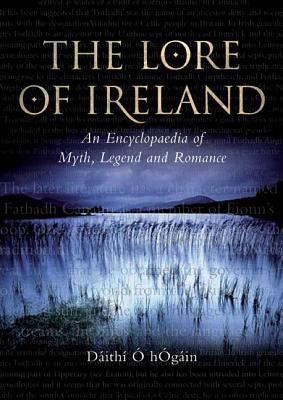 The Lore of Ireland is a magical phrase, calling up images of heroic deeds and fey enchantments, bloody treachery and shining honor, great warriors, cold queens of the Sidhe, leprechauns, cattle raids, enchanted groves, bards, prophecies — it’s sobering to think how much of our collective folklore, our everyday vernacular imagery, comes from Ireland.
The Lore of Ireland is a magical phrase, calling up images of heroic deeds and fey enchantments, bloody treachery and shining honor, great warriors, cold queens of the Sidhe, leprechauns, cattle raids, enchanted groves, bards, prophecies — it’s sobering to think how much of our collective folklore, our everyday vernacular imagery, comes from Ireland.
Ó hÓgáin’s The Lore of Ireland is subtitled “An Encyclopedia of Myth, Legend and Romance.” That somewhat terse description hides a wealth of information in entries ranging from a short commentary on the mythical king Tighearnmhas (in whose reign gold was first discovered in Ireland, and who came to bad end) to an exhaustive discussion of the origins, permutations and meanings of the Fianna Cycle.
It’s a treasure house of names, places, stories and ideas — everything from a short biography of Ní Mháille (Grace O’Malley, a sixteenth-century pirate queen who once visited Queen Elizabeth) to St. Patrick, and from pigs to fairies (not as far apart as you might think.) I admit it — I spent hours wandering from cross-reference to cross-reference.
Ó hÓgáin is one of the foremost Irish folklorists, and this book is evidence not only of his erudition, but of his solid scholarship. Entries are related not only to their Irish sources, but also to earlier pan-Celtic and even Indo-European sources, as well as British and Continental originals. Documentation is thorough, in references at the ends of entries, and the bibliography seems to be exhaustive. Also included is a List of Genres, for those looking for particular areas of Irish folklore, and a pronunciation guide to the entries.
A couple of small grumps: those of us whose grasp of Irish geography is somewhat wanting would have appreciated a map or two, the more so because Ó hÓgáin carefully notes modern names for legendary and mythical places. Those of us who can’t quite figure out how to get to Donegal from Sligo, however, are at a loss. He often traces the transformation of Irish names from Old Irish to their medieval and modern forms, but again, we who find Irish spelling (and Gaelic in general) a terrifying mystery (especially those of us who vaguely remember that most of the letters aren’t really pronounced) would have appreciated some phonetic renderings in the entries, rather than in a separate section at the end. (And do brush up on your International Phonetic characters.)
So, there it is, from abair (“to speak,” including a short discussion of the oral and written traditions in Irish literature) to wonder stories. It’s more than a valuable resource for anyone who needs a handy reference on Irish folklore — it’s fascinating reading.
(The Boydell Press and The Collins Press, 2006)
